sponsored by accessiBe
First of all, what is web accessibility and how does it work? So, web accessibility is an inclusive practice that makes sure everybody can use the Internet.
To be #inclusive, #websites have to be made in a way that no matter the #disabilities one has, he or she can use the website effortlessly.
Imagine you can’t use the Internet for even just a few days. How would you feel? At first, you would probably miss it, but then you’d get used to it. However, you know that you can always get back on it. Unfortunately, some people don’t have the same ability.
Why web accessibility matters

A large number of the population has some sort of disability. For them, it can be very hard to access certain websites online. That’s why the WCAG (Web Content Accessibility Guidelines) standard was established. It aims to create a standard for the accessibility of the Internet so that people with certain disabilities will be able to browse it freely and efficiently. However, when websites are badly designed, they present a barrier that can exclude people from using the Internet.
Web accessibility means that people with disabilities can perceive, understand, navigate, and interact with the Web, as well as contribute to it.
Accessibility benefits various businesses as well. Accessible design improves overall user experience and satisfaction, in a variety of situations, across different devices, and for older users. It can enhance your brand, broaden your audience, and extend your market reach. It greatly improves the user experience for people with disabilities, but not only for them.
Web accessibility around the world
When you create a website, it is best to immediately implement codes that would make it accessible to everyone, so you don’t have to re-do it and re-design it.
If you live in the United States, applicable laws include The Americans with Disabilities Act(ADA) and the Rehabilitation Act of 1973. There are also many international laws that address accessibility. Some countries that have web accessibility legislation are Australia, Malta, Japan, United Kingdom, Brazil, Canada, countries in the European Union, and more.

If you are a brand owner and want to make a website, keep in mind everyone who may want to visit it. Try to be as inclusive as possible, because individuals with disabilities make up a large percentage of the population.
Now that we have covered everything you should know about web accessibility, here is a review of a web accessibility solution that makes sure your website can be used by every person that comes across it.
accessiBe
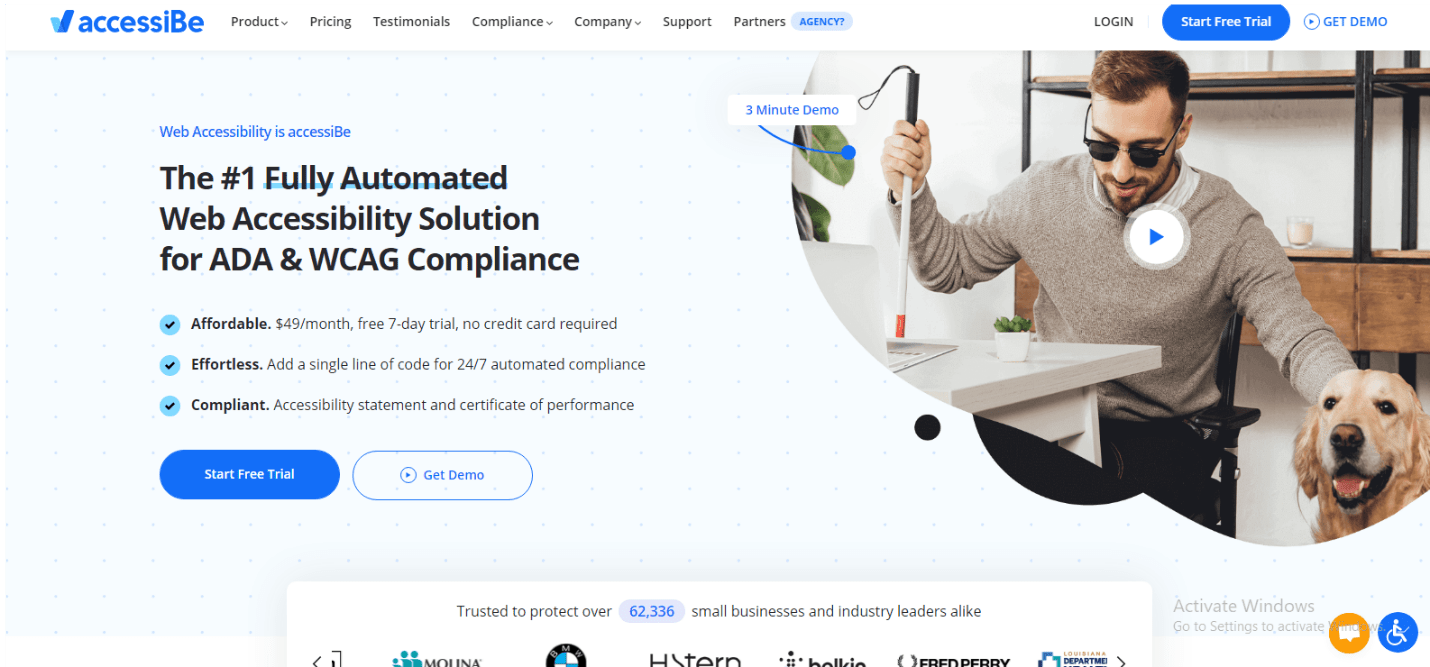
accessiBe utilizes two applications to achieve full compliance. It scans your website and alerts you on what is wrong and what should be changed. The accessibility interface is responsible for all design adjustments while the AI-powered background process handles screen-reader and keyboard navigation optimizations.
The setup is pretty simple, with 5 easy steps: First, you install a single line of JavaScript code. The accessibility interface then automatically appears on your website and the AI starts scanning and analyzing your website. After up to 48 hours, your website is fully compliant and certified. And then, every 24 hours, your website is scanned for new and revised content to fix.
Accessibility interface
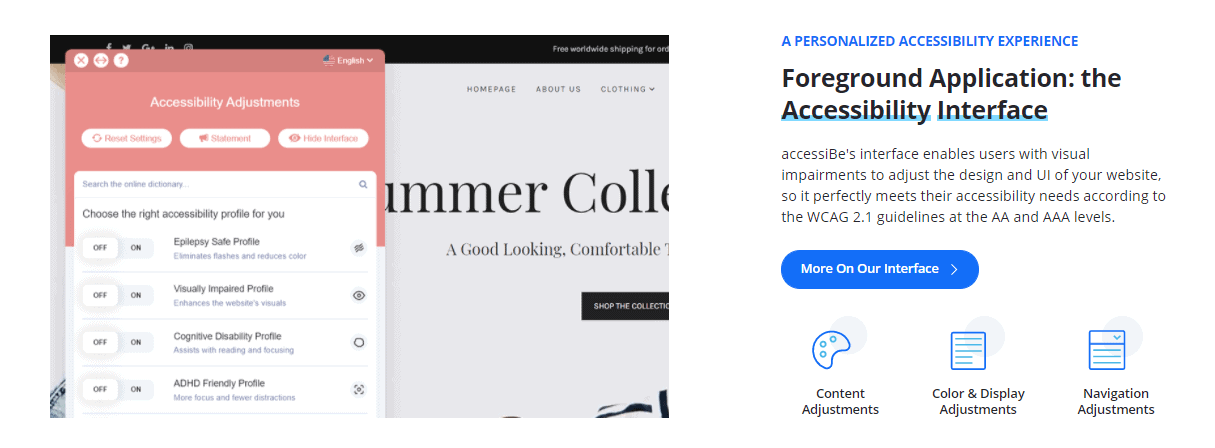
The accessibility interface lets every visitor personally adjust the page so it suits their individual needs, abilities, or disabilities. It is essentially a menu that allows users with various disabilities to adjust the UI and design elements. By using the menu, visually impaired users, users with cognitive disabilities, epileptic users, and others can modify your website to fit their needs.
There are also options to change font sizes, color contrasts, animations, and more.
- Epilepsy safe profile makes sure that there are no flashing or blinking animations and risky color combinations.
- Visually impaired profile adjusts the website to be accessible to the majority of people with visual impairments.
Other profiles include cognitive disability profile, ADHD friendly profile, blind users profile, and keyboard navigation profile. Each of these profiles works in a way that when a visitor chooses it, it automatically adjusts the whole website.
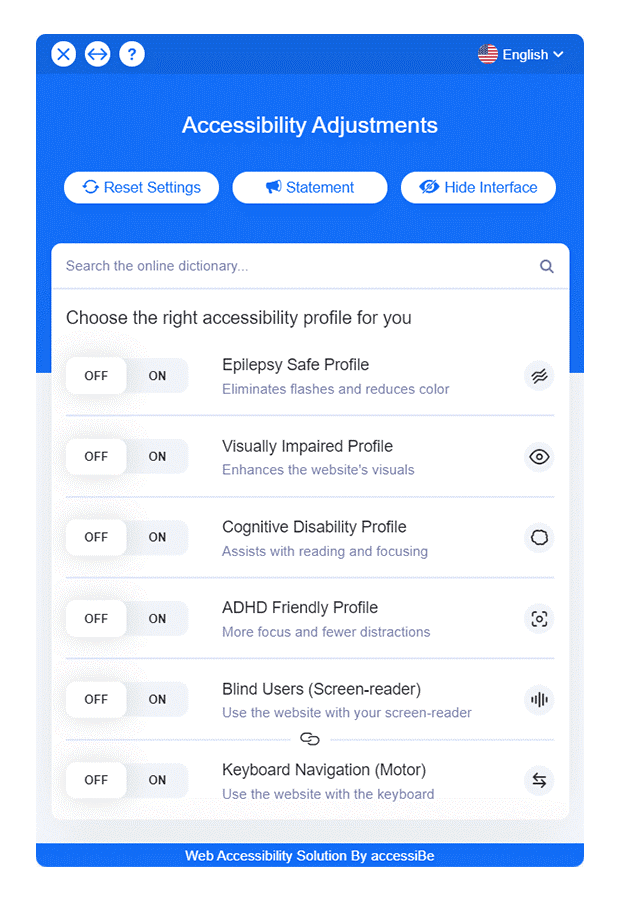
With content adjustments, you can control every aspect of the written material on your website. There is Content scaling, Readable font, Highlight titles, Highlight links, Text magnifier, Text align, Adjust letter spacing, and Adjust line-height. Visitors can alter all of the content that is on the page to make it easier to follow and to read.
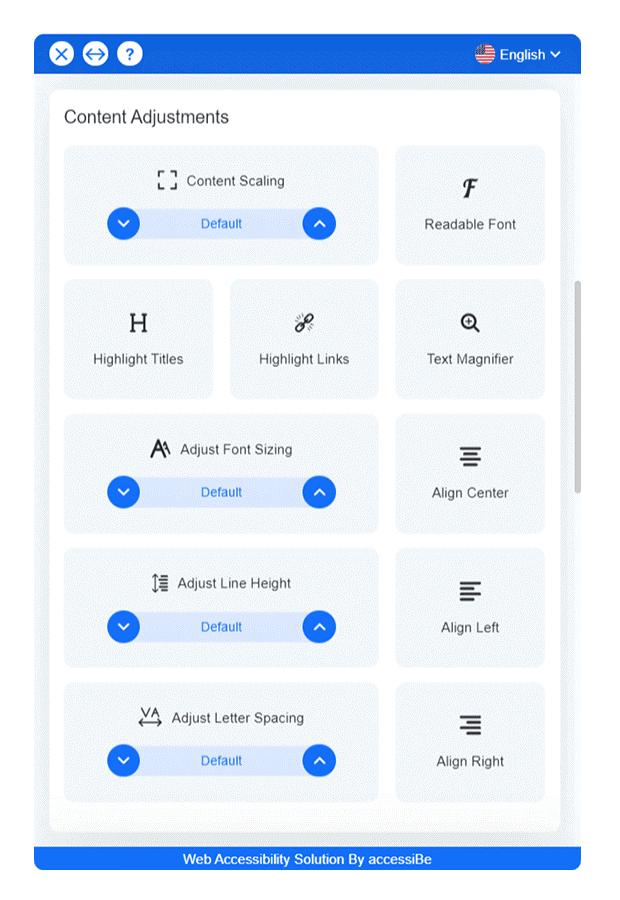
The color adjustments are mainly oriented towards people with various degrees of color blindness who may not be able to see certain buttons or links due to their color. Also, people with light sensitivity may not be able to enjoy your page if it has a very bright background. People with those kinds of disabilities would utilize adjustments such as Invert colors, High/light contrast, High/low saturation, Monochrome, Text colorization, Title colorization, and Background colorization.
Next, the orientation adjustments are meant to enable people with visual impairments, cognitive disabilities, and motor impairments to orient easily on the website. With orientation adjustments, visitors can have full control of distractions that could make it hard for them to browse the website. Those adjustments allow users to mute sounds, hide images, stop animations, have an enlarged cursor or reading assistance.
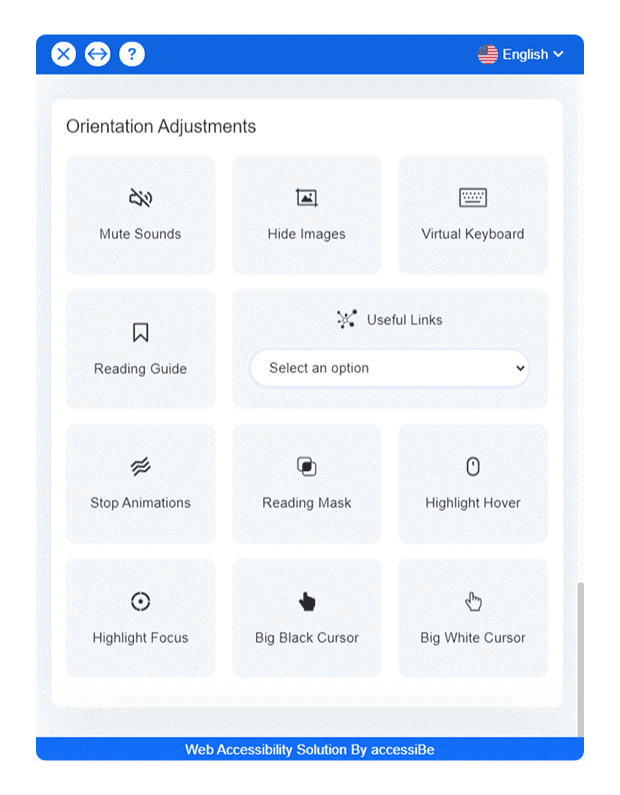
On the accessibility interface, visitors can also choose between 12 different languages and use an online dictionary which is particularly useful for users with cognitive disorders. The dictionary provides instant meaning for certain phrases, language, or slang that can be hard to comprehend.
AI Technology
Aside from the accessibility interface, accessiBe works in the background as well. accessiBe’s Contextual Understanding AI technology handles the most complex requirements, using machine learning and computer vision. Basically, it is an automated, AI-powered analysis of compatibility and accessibility requirements and also the fixing of parts that need adjusting.
AI analyzes the context of the website, what it does and what is its purpose. It is also responsible for the most challenging parts, like screen reader and keyboard navigation accessibility.
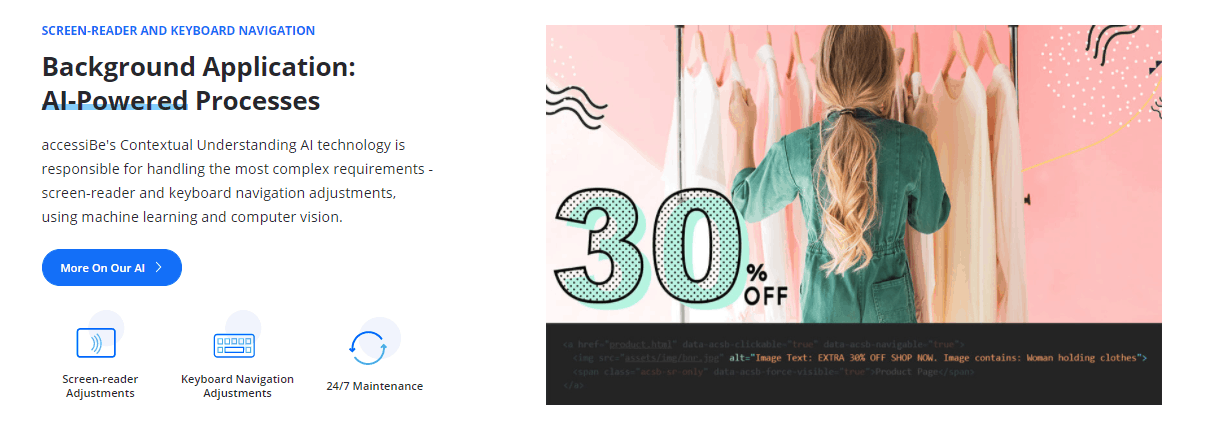
A screen reader is a software used by blind people to browse the web and use computers. It is pretty self-explanatory, but the way it works is that it reads aloud what is seen on the screen. When a blind user enters the page with the screen reader, accessiBe utilizes various image, object, and character recognition technologies to provide descriptive and accurate descriptions of images that are displayed on the page.
accessiBe scans the code of the website and adds keyboard functionalities and ARIA tags to various website elements. When scanning a website it implements all of the required adjustments to achieve full compliance.
AI Applications for Web Accessibility
- Popups – shift the focus of the popup, lock its navigation, and enable dismissal
- Menus – identify and interpret to screen readers, navigate with arrow keys
- Dropdowns – navigate with arrow keys, locks up navigation focus
- Buttons – identify text and link elements, enable keyboard operation
- Forms – announce requirements and validations, identify error and success messages
- Images – provide accurate alternative texts
- Icons – identify purpose correctly
- Links – identify links that open new windows
accessiBe vs. accessibility services and accessibility plugins
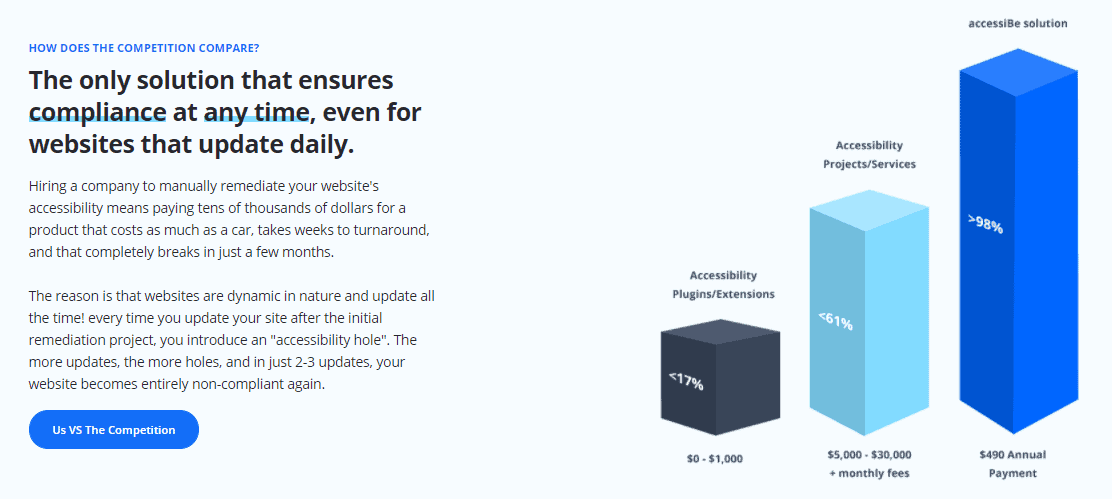
accessiBe’s AI solution is the only automatic solution and it is compliant with WCAG, ADA, s508, and more. The turnaround is up to 48 hours from the installation and has the highest success rate.
accessiBe allows you to design your website in whichever way you think is the best for your brand, user experience, or marketing efforts. It is installed with a single line of JavaScript code and modifies your website code at the browser level only. Furthermore, it re-scans and re-analyzes each page of the website once every 24 hours to ensure that every new update, addition, or content revision is made compliant instantly.
The process of setting up fully takes up to 48 hours and is completely automatic, beginning at the moment of installation.
Accessibility plugins on the other hand, only answer front-end requirements which means after installing them, you are only half compliant. They do not comply with legislation, have no full turnaround, and don’t include maintenance.
The same goes for popular web accessibility widgets such as Userway which does provide an accessibility toolbar but does not make your website totally accessible. Meaning that, while it is a great accessibility tool, it does not cover many requirements (21 accessibility requirements to be exact) which is an issue explained very clearly in this post.
Accessibility services are much more pricey, projects take up to 26 weeks, their success drops by 50% after 6 months, and you require additional services for maintenance.
accessiBe can operate on any website or platform and some of the available integrations are – Google Tag Manager, WordPress, SquareSpace, Shopify, Joomla, Magento, BigCommerse, and much more.
accessiBe’s prices
There are 4 different plans, which all include all the features and services, and the prices of the plans are based on page count. accessiBe considers every unique URL as a page. So if a page has URL parameters, all variations are considered as one page.

The plans are called Standard, Large, Huge, and Jumbo. Standard is for websites under 1,000 unique pages and is 490$/year. Large is for websites under 10,000 unique pages and is 1,490$/year. Huge is for websites under 100,000 unique pages and is 1,990$/year, while Jumbo is for websites under 1,000,000 unique pages and is 3,490$/year.
Each plan can be tried out over a 7-day trial period.
Final thoughts
Web accessibility is very important because you could possibly get sued if your website is not ADA and WCAG compliant. The second reason why it is important is that it allows people with disabilities to browse your website, which broadens your audience and is the right thing to do.
Being accessible makes your website more approachable and attractive, it creates more potential customers and also tells the world that you actually care about people who may not have the ability to view the Internet in the same way you do.
accessiBe ensures you are compliant and you stay that way. It is also time-efficient, cost-effective, completely automated and a single provider for full compliance.